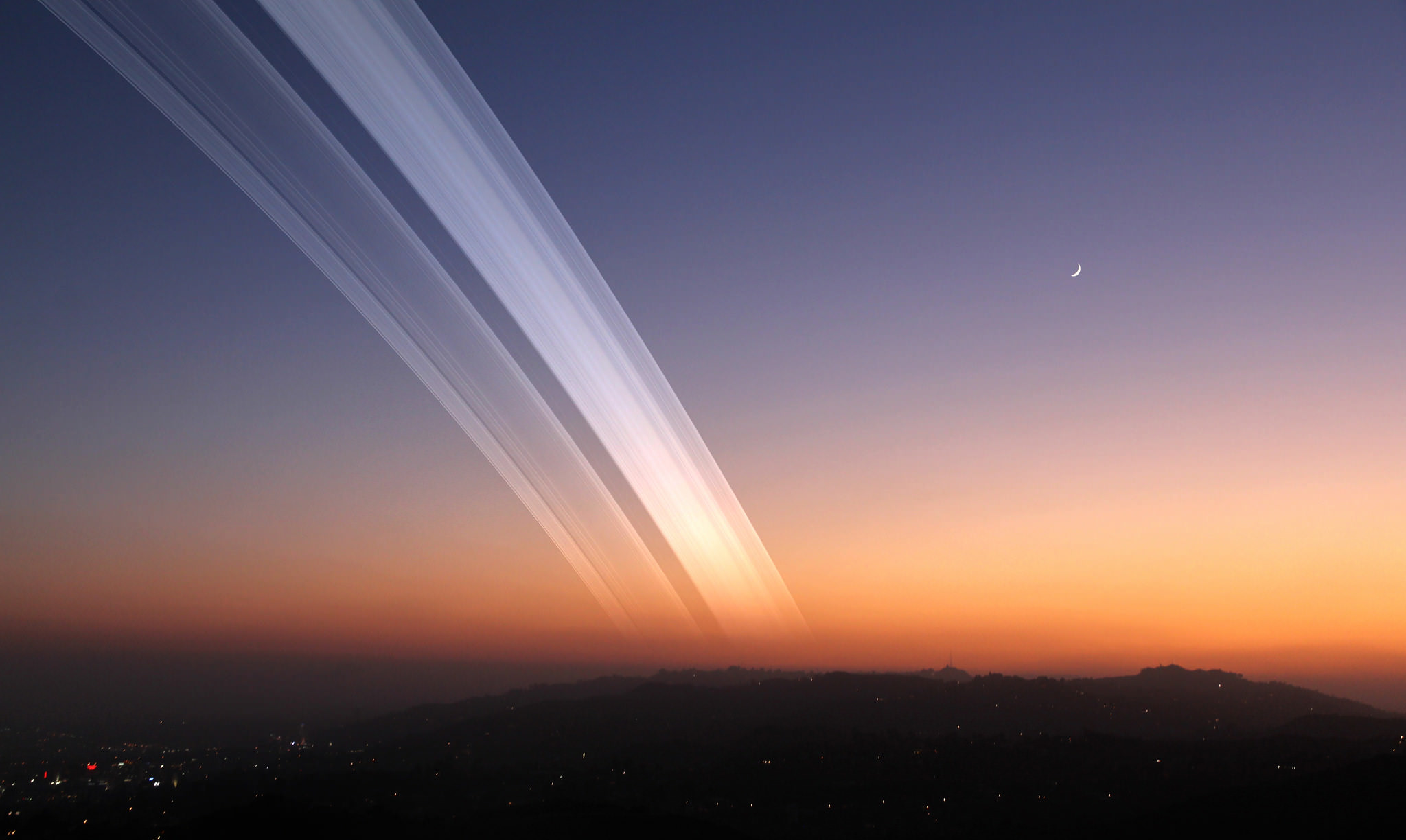Earth releases about as much energy out into space as it absorbs, arriving at a thermal equilibrium. This means it will reach an average temperature as is the case with most planets. Saturn however, is a little different as recent observations show the planet’s energy is out of balance. It seems that in addition to the energy it receives from the Sun, there must also be an internal source of heat, perhaps driven by its highly elliptical orbit.
Continue reading “Saturn’s Energy is Out of Balance”Titan’s “Magic Islands” Could Be Floating Blobs of Organic Solids

When the Cassini spacecraft returned radar scans of the surface of Saturn’s moon Titan, the results were mindblowing. It revealed giant lakes or seas of liquid methane, a complete absence of waves and what seemed to be islands in the giant bodies of liquid. Now a team of scientists think they may be blobs of organic molecules that form in the atmosphere, collect in the lakes and float around!
Continue reading “Titan’s “Magic Islands” Could Be Floating Blobs of Organic Solids”Saturn’s ‘Fuzzy Core’ Seen In Ring Ripples
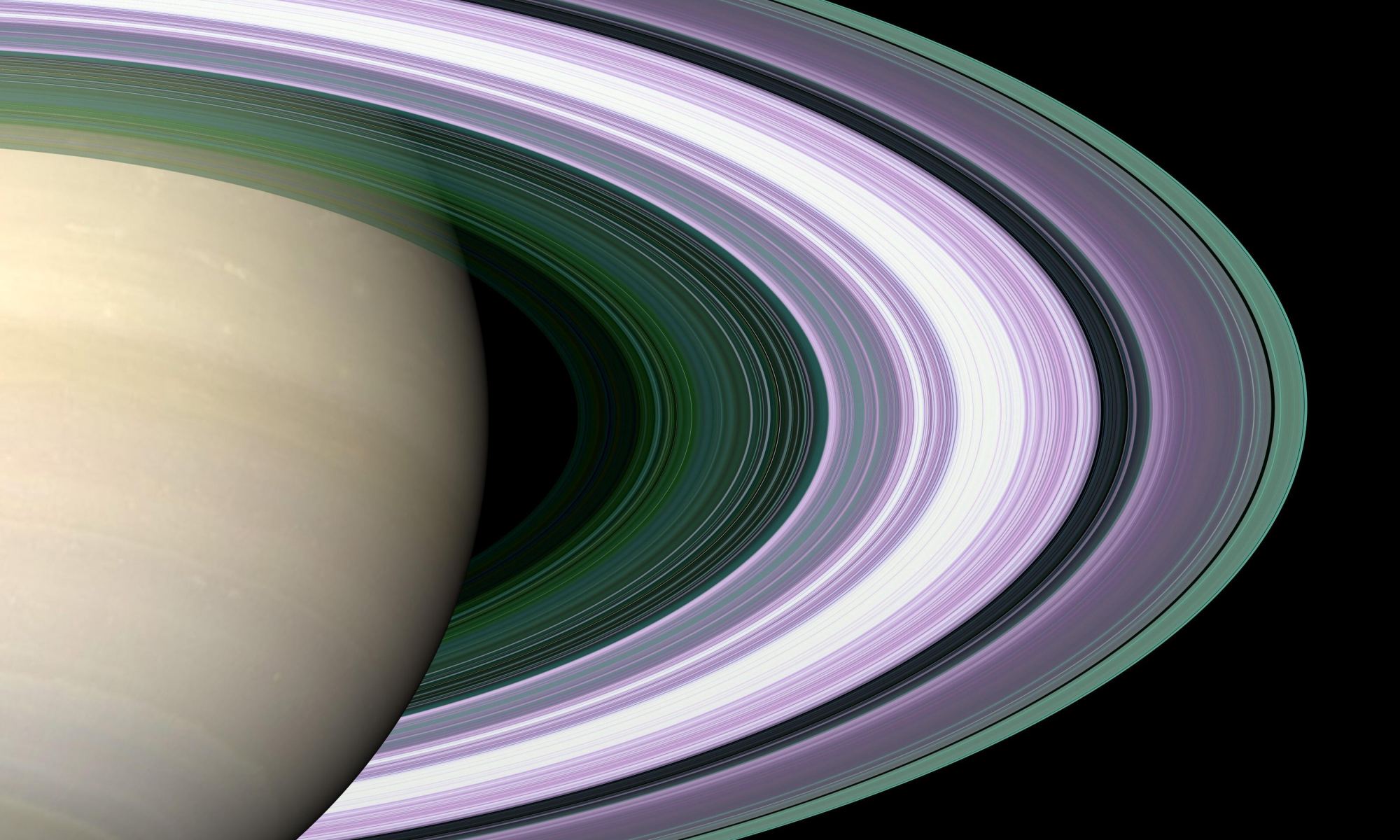
Seismic waves in Saturn’s rings reveal the strange ‘fuzzy core’ interior of the planet within.
NASA’s Cassini spacecraft continues to uncover amazing facts about the ringed planet Saturn. A recent study in the August edition of Nature: Astronomy highlighted an intriguing method to indirectly probe the interior of the planet.
Continue reading “Saturn’s ‘Fuzzy Core’ Seen In Ring Ripples”This is Why Saturn’s Rotation is So Hard to Measure

For a rocky planet, finding the length of a day can be simple. Just pick a reference point and watch how long it takes to rotate out of view, then back into view. But for planets like Saturn, it’s not so simple. There are no surface features to track.
Continue reading “This is Why Saturn’s Rotation is So Hard to Measure”Saturn’s Rings are Only 10 to 100 Million Years Old
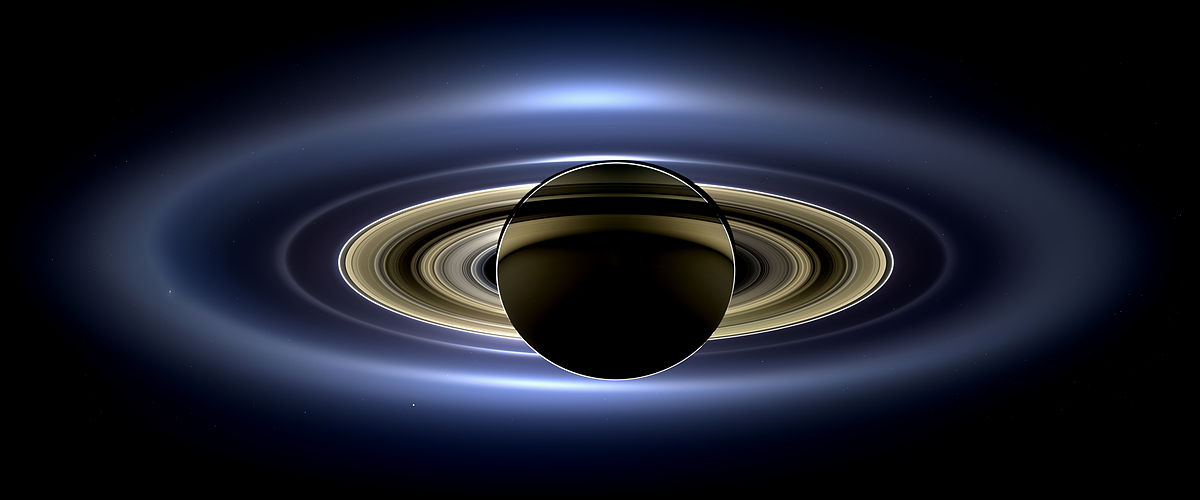
Can you imagine the Solar System without Saturn’s rings? Can you envision Earth at the time the dinosaurs roamed the planet? According to a new paper, the two may have coincided.
Data from the Cassini mission shows that Saturn’s rings may be only 10 to 100 million years old. They may not have been there during the reign of the dinosaurs, and may in fact be a fairly modern development in our Solar System.
Continue reading “Saturn’s Rings are Only 10 to 100 Million Years Old”New Saturn Storm Emerging?
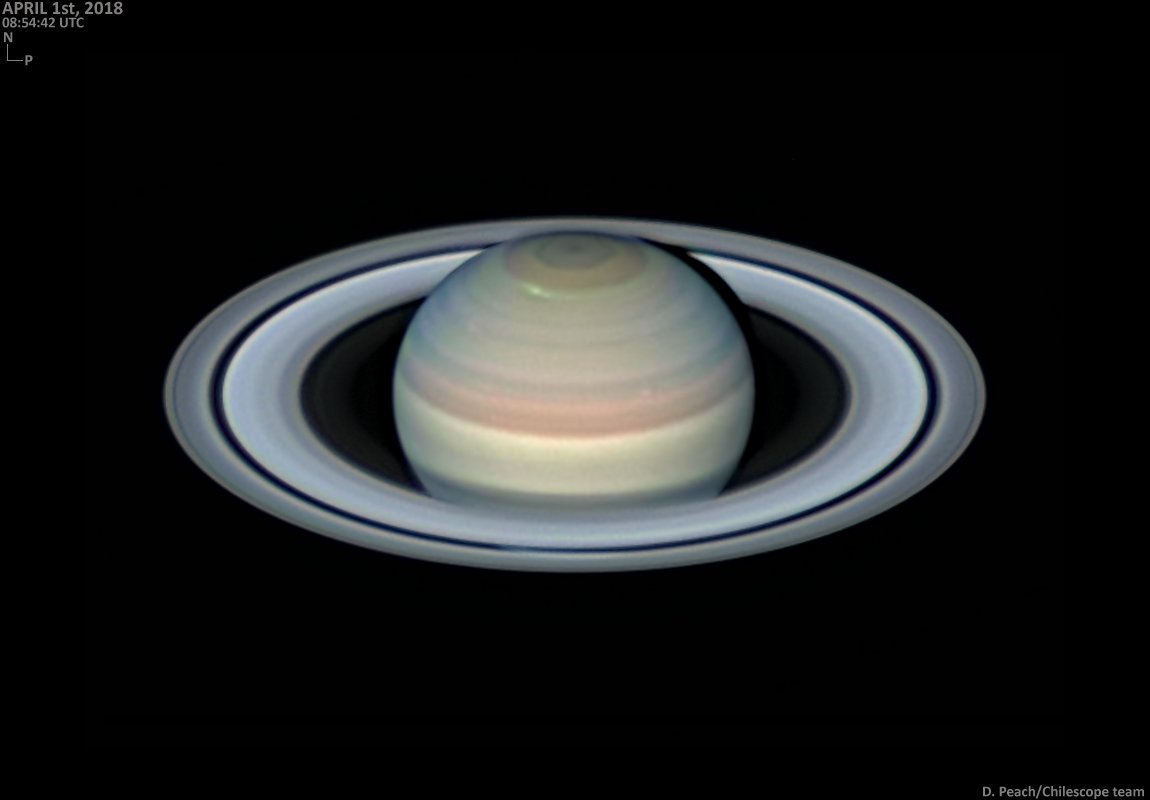
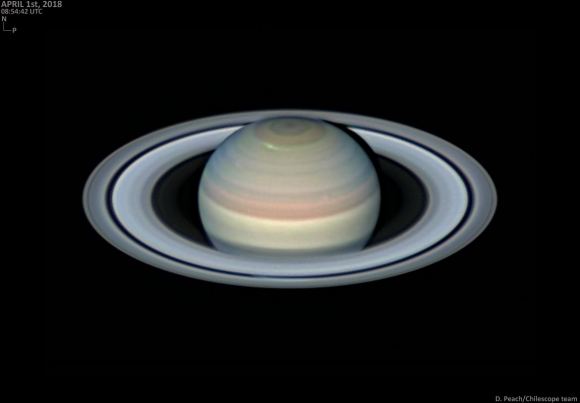
Are you following the planets this season? The planetary action is about to heat up, as Jupiter, Saturn and Mars all head towards fine oppositions over the next few months.
Spying the Storms of Saturn
Astrophotographer Damian Peach raised the alarm on Twitter this past week of a possible bright storm emerging of the planet Saturn. The spot was noticeable even with the naked eye and in the raw video Peach captured, a sure sign that the storm was a biggie.
Though outbursts of clusters of white spots on the surface of Saturn aren’t uncommon, it’s rare to see one emerge at such a high latitude. The storm had faded considerably the next observing session Peach performed on April 5th, though observers should remain vigilant.
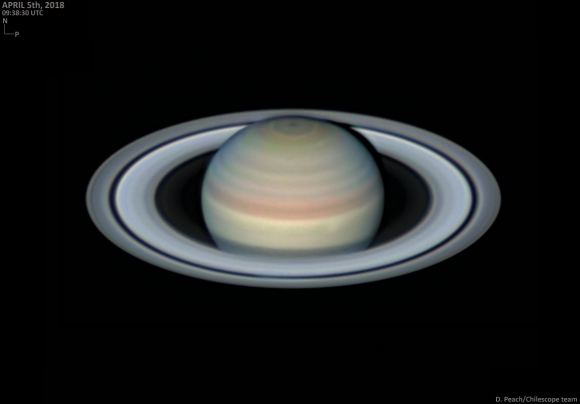
It’s sad to think: Cassini and our eyes in the outer solar system are no more… and the situation will probably remain this way for some years to come. Juno also wraps up its mission at Jupiter (pending extension) this year, and New Horizons visits its final destination Ultima Thule (neé 2014 MU69) on New Year’s Day 2019, though it’ll likely continue to chronicle its journey through the outer realms of the solar system, much like the Voyager 1, 2 and Pioneer 10, 11 missions, also bound to orbit the galaxy, mute testaments to human civilization. But even though proposals for Europa Clipper, a nuclear-powered quad-copter for Saturn’s moon Titan, and a Uranus and/or Neptune Orbiter are all on the drawing board, the “gap decade” of outer solar system exploration will indeed come to pass and soon.
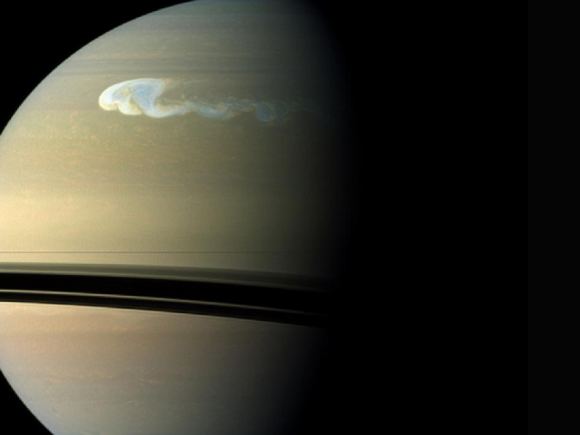
But dedicated amateur astronomers continue to monitor the outer solar system for changes. This month sees Saturn rising around 1:30 AM local and transiting highest to the south for northern hemisphere observers at 6:00 AM local, just before sunrise. Saturn crosses the constellation Sagittarius in 2018, bottoming out at its most southerly point this year for its 29 year path around the Sun. Saturn currently shines at +0.4 magnitude, extending 40” across (including rings) as it heads towards a fine opposition on June 27th. After opposition, Saturn formally crosses into the dusk sky. The amazing rings are an automatic draw, but last week’s storm admonishes us not to forget to check out the saffron-colored disk of Saturn itself as well. For example, I’ve always wondered: why didn’t we see the hexagon before? It’s right there festooning the northern hemisphere cap, plain as day in modern amateur images… to be sure, we’re in a modern renaissance of planetary astrophotography today, what with image stacking and processing, but surely eagle-eyed observers of yore could’ve easily picked this feature out.
And the view is changing as well, as Saturn’s rings reached a maximum tilt in respect to our line of sight of 27 degrees in 2017, and now head back towards edge-on again in 2025. And be sure to check out Saturn’s retinue of moons, half a dozen of which are easily visible in a telescope at even low power.
Finally, here’s another elemental mystery poised by Saturn related to the current storm, one that Cassini sought to solve in its final days: how fast does Saturn rotate, exactly? The usual rough guesstimate quoted is usually around 10.5 hours, but we’ve yet to pin down this fundamental value with any degree of precession.
One thing’s definitely for sure: we need to go back. In the meantime, we can enjoy the early morning views of the most glorious of the planets in our Solar System.
What Would Earth Look Like With Rings?
Saturn’s Rings are amazing to behold. Since they were first observed by Galileo in 1610, they have been the subject of endless scientific interest and popular fascination. Composed of billions of particles of dust and ice, these rings span a distance of about 282,000 km (175,000 miles) – which is three quarters of the distance between the Earth and its Moon – and hold roughly 30 quintillion kilograms (that’s 3.0. x 1018 kg) worth of matter.
All of the Solar System’s gas giants, from Jupiter to Neptune, have their own ring system – albeit less visible and picturesque ones. Sadly, none of the terrestrial planets (i.e. Mercury, Venus, Earth and Mars) have such a system. But just what would it look like if Earth did? Putting aside the physical requirements that it would take for a ring system to exist, what would it be like to look up from Earth and see beautiful rings reaching overhead?
The Moon Occults Saturn in the Dawn this Weekend
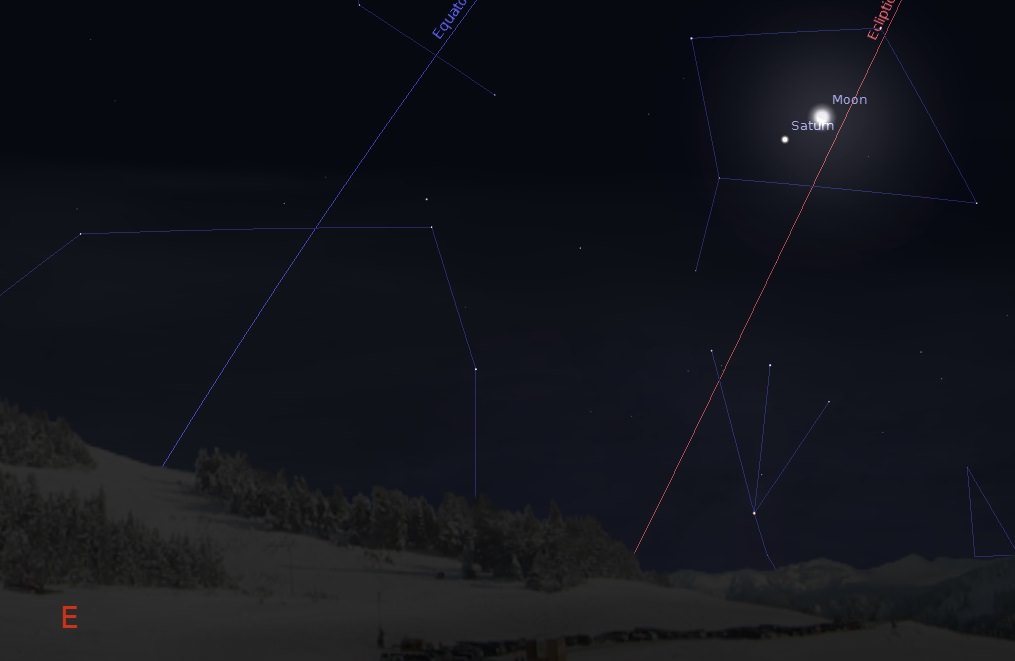
Mark your calendars: the first in a series of interesting occultations of Saturn by the Moon for 2014 starts this weekend.
The year 2014 features 11 occultations of the planet Saturn by the Moon, and there are 23 total for 2014 of every planet except Neptune and Jupiter.
An occultation occurs when one foreground celestial object completely obscures another. Technically, a total solar eclipse is an occultation of the Sun by the Moon, although it’s never referred to as such. The term finds modern usage mainly for the blocking of stars and planets by the Moon. Very occasionally, an asteroid or planet can occult a distant star as well.
And yes, the modern astronomical term “occultation” traces its hoary roots back to the days when astronomy was intertwined with the pseudoscience of astrology. To this day, the term still makes some folks wonder if astronomers are secretly casting horoscopes. Trust us, you’re still on a solid astronomical footing to use the term “occultation.”
Unfortunately, the January 25th occultation of Saturn by the Moon will only grace part of Antarctica, southern Argentina and Chile, and the Falkland Islands post-sunrise. The rest of us still will see a very photogenic pass of Saturn near the waning crescent Moon on the morning of Saturday, January 25th. The Moon will pass just about a degree — two times its apparent width — south of Saturn for northern hemisphere observers.
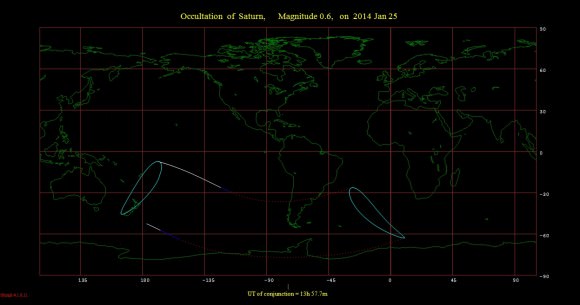
Both the Moon and Saturn will reside in the astronomical constellation of Libra this weekend during closest passage. The pair will rise around 2 AM local. After their brief tryst, the Moon will head towards New on January 30th while Saturn will continue to rise successively earlier as its heads towards opposition and the start of evening Saturn observing season on May 10th, 2014.
January 2014 is also notable for having two New Moons, an occurrence informally known as a Black Moon. This occurs again this year in March, and February 2014 is devoid of a New Moon. February is the only month that can be “missing a Moon phase” as it’s the only one shorter the synodic period of 29.5 days, in which the Moon returns to like phase.
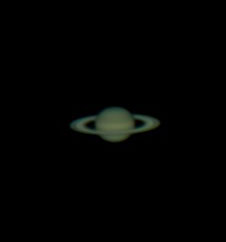
In the telescope, Saturn will present a +0.8 magnitude disk 16” across (38” with rings from tip-to-tip). Saturn’s rings are tipped open to our line of sight by about 22 degrees in 2014, and are widening towards a maximum of 27 degrees in 2016 through 2017. If you have an equatorial telescope with tracking capability, it may be possible this weekend to follow Saturn up into the daytime sky. Though Saturn isn’t quite bright enough to see in the daytime unaided, it might just be possible to spy using binoculars on the 25th using the nearby crescent Moon as a guide. Saturn is a tough daytime target to be sure, but it’s not impossible to acquire with a little skill and patience.
The current cycle of occultations of Saturn began on December 1st, 2013 and ends on November 22nd, 2014. The cycle will move progressively northward through the year.
The Moon and Saturn put on a repeat performance over almost the same exact location (this time in darkness) on April 17th, 2014, and the best event in the cycle for North America will be the August 31st daytime occultation of Saturn by the waxing crescent Moon.
Now for the wow factor of what you’re seeing. On Saturday morning, the Moon is just over 371,000 kilometres distant, or a little over a light second away. Saturn is over four thousand times more remote at just over 10.1 astronomical units (AUs) distant, which works out to 1.5 billion kilometres, or over 83 light minutes away. And although the Moon is over a 112 times larger in apparent diameter than Saturn as seen from the Earth, the globe of Saturn is actually over 34 times bigger.
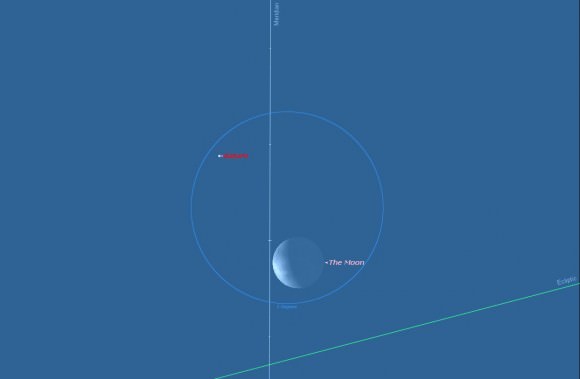
And though we’ve been to the Moon lots since the dawn of the Space Age, only two spacecraft (Voyagers 1 and 2) have made brief flybys of the ringed world, and only one – Cassini – has orbited it. Note that China’s Chang’e-3 lander and rover are about to experience their second sunset this weekend as well from the lunar surface since landing on the Moon last month.
And although lots of planets get occulted by the Moon in 2014, no stars brighter than +1st magnitude lie in its path. In fact, the next cycle of bright star occultations by the Moon doesn’t resume until the Moon meets Aldebaran in January 29th, 2015.
There are, however, over a 100 lesser events involving the Moon occulting naked eye stars worldwide in 2014. Two such events occur this week as well, when the 48% illuminated Moon occults the +4.5th magnitude star Lambda Virginis for west-central South America on the morning of January 24th, and the occultation of the +2.8th magnitude star Alpha Librae (Zubenelgenubi) for central Asia on January 25th.
Don’t miss these celestial events, and be sure to send those pics in to Universe Today… there’s something for everyone happening in the sky this week worldwide!
Earthlings Wave at Saturn as Cassini Images Us
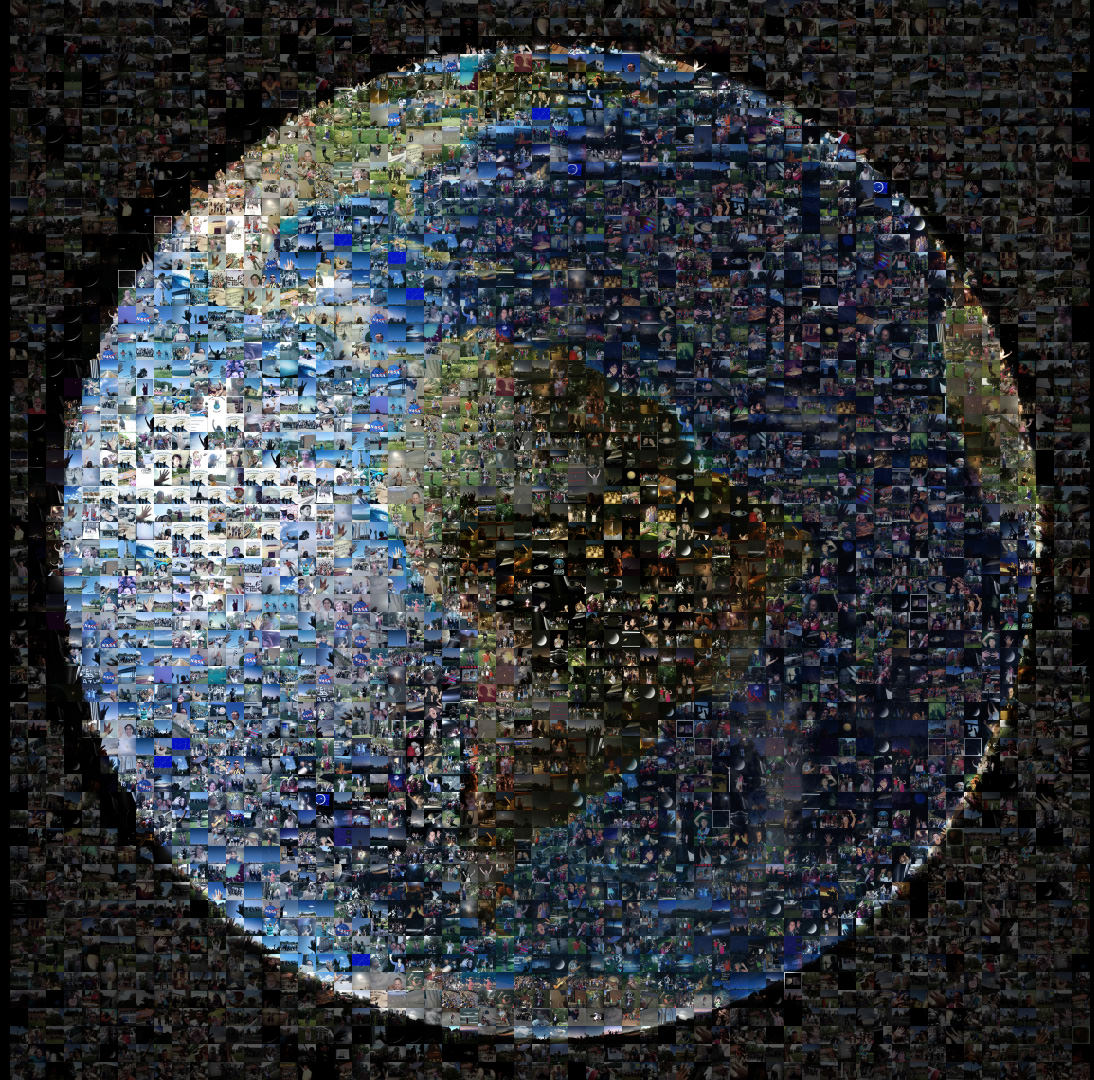
Earth Waves at Saturn and Cassini on July 19, 2013
From more than 40 countries and 30 U.S. states, people around the world shared more than 1,400 images of themselves as part of the Wave at Saturn event organized by NASA’s Cassini mission on July 19, 2013. The Cassini team created this image collage as a tribute to the people of Earth
Credit: NASA/JPL-Caltech/People of Earth
See link below to the absolutely gigantic full resolution version [/caption]
On July 19, millions of Earthlings worldwide participated in NASA’s ‘Wave at Saturn’ campaign as the NASA Cassini Saturn orbiter turned about and imaged all of us.
Earthlings from 40 countries and 30 U.S. states heeded NASA’s call to photograph themselves while smiling and waving at Saturn and Cassini across 1 billion miles of interplanetary space and shared over 1400 images.
The results of all those images has now been assembled into a fabulous collage in the shape of our planet and released today (Aug. 21) by NASA and the Cassini team as a tribute to the People of Earth.
“Did you wave at Saturn and send us your photo? Then here’s looking at you!” NASA announced on the Cassini Facebook page.
This event was the first time that the citizens of Earth knew in advance that a distant interplanetary spacecraft was photographing portraits of our home planet and our Moon. NASA invited everyone to participate.
Photos flooded into NASA via Twitter, Facebook, Flickr, Instagram, Google+ and email.
Click here for the full resolution version. But be forewarned – it weighs in at over 26 MB and it’s far too big to post here.
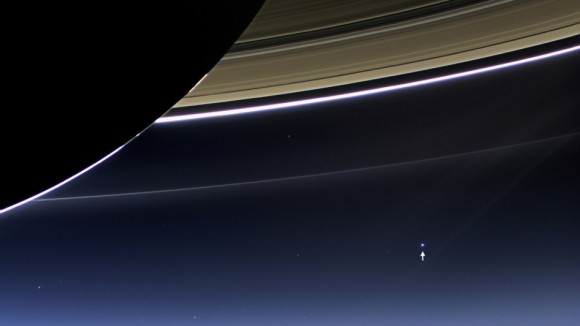
In this rare image taken on July 19, 2013, the wide-angle camera on NASA’s Cassini spacecraft has captured Saturn’s rings and our planet Earth and its moon in the same frame. Image Credit: NASA/JPL-Caltech/Space Science Institute
“Thanks to all of you, near and far, old and young, who joined the Cassini mission in marking the first time inhabitants of Earth had advance notice that our picture was being taken from interplanetary distances,” said Linda Spilker, Cassini project scientist at NASA’s Jet Propulsion Laboratory, Pasadena, Calif, in a statement.
“While Earth is too small in the images Cassini obtained to distinguish any individual human beings, the mission has put together this collage so that we can celebrate all your waving hands, uplifted paws, smiling faces and artwork.”
The Cassini imaging science team is still assembling the hundreds of images of Saturn and Earth snapped by the spacecraft as we were waving, to create individual color composites and a panoramic view of the ‘pale blue dot’ and the entire Saturnian system.
To capture all of Saturn and its wide swath of rings, Cassini’s wide angle camera snapped a mosaic of 33 footprints on July 19, 2013.
“At each footprint, images were taken in different spectral filters for a total of 323 images,” says Carolyn Porco, Cassini Imaging Team leader, Space Science Institute in Boulder, Colo.
Cassini took the pictures of Earth from a distance of about 898 million miles (1.44 billion kilometers) away from the home to every human being that has ever lived.
Here is our partial version of Cassini’s mosaic.

Cassini was launched from Florida in 1997.
It achieved orbit at Saturn in 2004 and has transmitted breathtaking images and science that revolutionized our understanding of the Saturnian system.
The mission is scheduled to continue until 2017 when it will commit a suicide death dive into the humongous gas giant.
Coincidentally, the first humans (Neil Armstrong and Buzz Aldrin) set foot on the Moon 44 years ago nearly to the day of Cassini’s Earth-Moon portrait on July 20, 1969 aboard Apollo 11.
And likewise on July 19, 2013, billionaire space enthusiast Jeff Bezos announced that his dive teams had recovered components of an Apollo 11 first stage F-1 rocket engine from the Saturn V moon rocket that propelled the first humans to the Moon.

2011: Top Stories from the Best Year Ever for NASA Planetary Science!
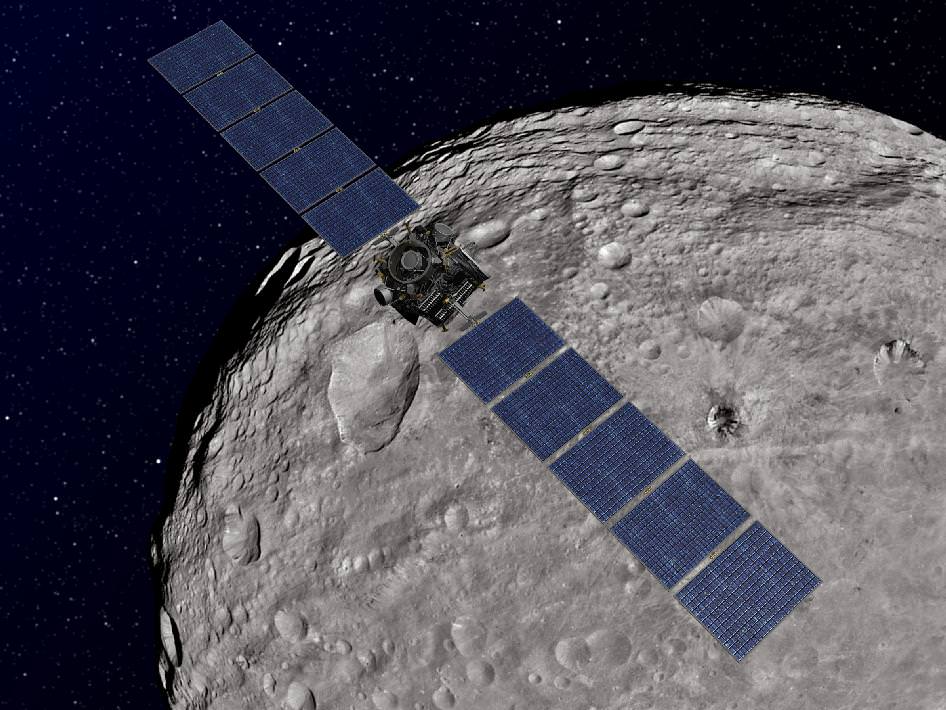
[/caption]
A year ago, 2011 was proclaimed as the “Year of the Solar System” by NASA’s Planetary Science division. And what a year of excitement it was indeed for the planetary science community, amateur astronomers and the general public alike !
NASA successfully delivered astounding results on all fronts – On the Story of How We Came to Be.
“2011 was definitely the best year ever for NASA Planetary Science!” said Jim Green in an exclusive interview with Universe Today. Green is the Director of Planetary Science for the Science Mission Directorate at NASA HQ. “The Search for Life is a significant priority for NASA.”
This past year was without doubt simply breathtaking in scope in terms of new missions, new discoveries and extraordinary technical achievements. The comprehensive list of celestial targets investigated in 2011 spanned virtually every type of object in our solar system – from the innermost planet to the outermost reaches nearly touching interplanetary space.
There was even a stunningly evocative picture showing “All of Humanity” – especially appropriate now in this Holiday season !
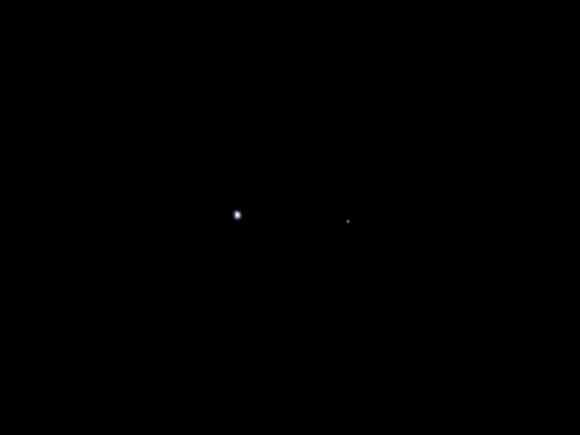
-- Earth & Moon Portrait by Juno from 6 Million miles away --
First Photo transmitted from Jupiter Bound Juno shows Earth (on the left) and the Moon (on the right). Taken on Aug. 26, 2011 when spacecraft was about 6 million miles (9.66 million kilometers) away from Earth. Credit: NASA/JPL-Caltech
Three brand new missions were launched and ongoing missions orbited a planet and an asteroid and flew past a comet.
“NASA has never had the pace of so many planetary launches in such a short time,” said Green.
And three missions here were awarded ‘Best of 2011’ for innovation !
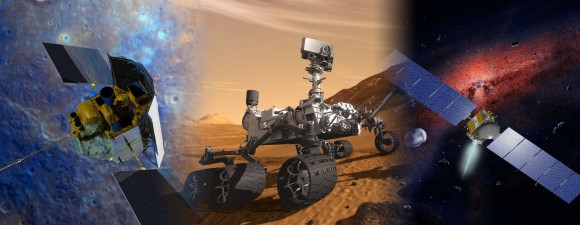
Here’s the Top NASA Planetary Science Stories of 2011 – ‘The Year of the Solar System’ – in chronological order
1. Stardust-NExT Fly By of Comet Tempel 1
Starting from the first moments of 2011 at the dawn of Jan. 1, hopes were already running high for planetary scientists and engineers busily engaged in setting up a romantic celestial date in space between a volatile icy comet and an aging, thrusting probe on Valentine’s Day.
The comet chasing Stardust-Next spacecraft successfully zoomed past Comet Tempel 1 on Feb. 14 at 10.9 km/sec (24,000 MPH) after flying over 6 Billion kilometers (3.5 Billion mi).
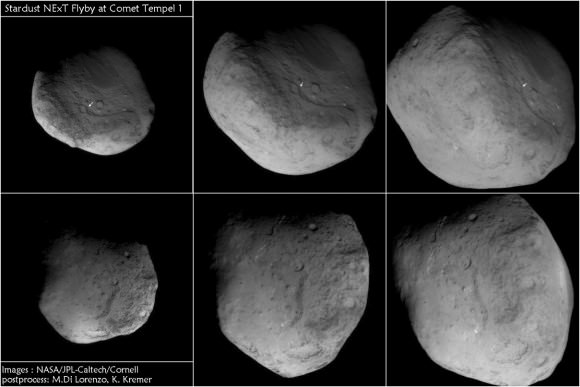
Arrows show location of man-made crater created in 2005 by NASA’s prior Deep Impact comet mission and newly imaged as Stardust-NExT zoomed past comet in 2011. The images progress in time during closest approach to comet beginning at upper left and moving clockwise to lower left. Credit: NASA/JPL-Caltech/University of Maryland. Post process and annotations by Marco Di Lorenzo & Kenneth Kremer
The craft approached within 178 km (111mi) and snapped 72 astonishingly detailed high resolution science images over barely 8 minutes. It also fulfilled the teams highest hopes by photographing the human-made crater created on Tempel 1 in 2005 by a cosmic collision with a penetrator hurled by NASA’s Deep Impact spacecraft. The probe previously flew by Comet Wild 2 in 2004 and returned cometary coma particles to Earth in 2006
Tempel 1 is the first comet to be visited by two spaceships from Earth and provided the first-ever opportunity to compare observations on two successive passages around the Sun.
Don Brownlee, the original Principal Investigator, summarized the results for Universe Today; “A great bonus of the mission was the ability to flyby two comets and take images and measurements. The wonderfully successful flyby of Comet Tempel 1 was a great cap to the 12 year mission and provided a great deal of new information to study the diversity among comets.”
“The new images of Tempel showed features that form a link between seemingly disparate surface features of the 4 comets imaged by spacecraft. Combining data on the same comet from the Deep Impact and Stardust missions has provided important new insights in to how comet surfaces evolve over time and how they release gas and dust into space”.
2. MESSENGER at Mercury
On March 18, the Mercury Surface, Space Environment, Geochemistry, and Ranging, or MESSENGER, spacecraft became the first spacecraft inserted into orbit around Mercury, the innermost planet.
So far MESSENGER has completed 1 solar day – 176 Earth days- circling above Mercury. The probe has collected a treasure trove of new data from the seven instruments onboard yielding a scientific bonanza; these include global imagery of most of the surface, measurements of the planet’s surface chemical composition, topographic evidence for significant amounts of water ice, magnetic field and interactions with the solar wind.
“MESSENGER discovered that Mercury has an enormous core, larger than Earth’s. We are trying to understand why that is and why Mercury’s density is similar to Earth’s,” Jim Green explained to Universe Today.

After its first Mercury solar day (176 Earth days) in orbit, MESSENGER has nearly completed two of its main global imaging campaigns: a monochrome map at 250 m/pixel and an eight-color, 1-km/pixel color map. Small gaps will be filled in during the next solar day. Credit: NASA/Johns Hopkins University Applied Physics Laboratory/Carnegie Institution of Washington
“The primary mission lasts 2 solar days, equivalent to 4 Mercury years.”
“NASA has granted a 1 year mission extension, for a total of 8 Mercury years. This will allow the team to understand the environment at Mercury during Solar Maximum for the first time. All prior spacecraft observations were closer to solar minimum,” said Green.
MESSENGER was launched in 2004 and the goal is to produce the first global scientific observations of Mercury and piece together the puzzle of how Mercury fits in with the origin and evolution of our solar system.
NASA’s Mariner 10 was the only previous robotic probe to explore Mercury, during three flyby’s back in the mid-1970’s early in the space age.
3. Dawn Asteroid Orbiter
The Dawn spacecraft achieved orbit around the giant asteroid Vesta in July 2011 after a four year interplanetary cruise and began transmitting the history making first ever close-up observations of the mysteriously diverse and alien world that is nothing short of a ‘Space Spectacular’.
“We do not have a good analog to Vesta anywhere else in the Solar System,” Chris Russell said to Universe Today. Russell, from UCLA, is the scientific Principal Investigator for Dawn.
Before Dawn, Vesta was just another fuzzy blob in the most powerful telescopes. Dawn has completely unveiled Vesta as a remarkably dichotomous, heavily battered and pockmarked world that’s littered with thousands of craters, mountains and landslides and ringed by mystifying grooves and troughs. It will unlock details about the elemental abundances, chemical composition and interior structure of this marvelously intriguing body.
Cataclysmic collisions eons ago excavated Vesta so it lacks a south pole. Dawn discovered that what unexpectedly remains is an enormous mountain some 16 miles (25 kilometers) high, twice the height of Mt. Everest.
Dawn is now about midway through its 1 year mission at Vesta which ends in July 2012 with a departure for Ceres, the largest asteroid. So far the framing cameras have snapped more than 10,000 never-before-seen images.
“What can be more exciting than to explore an alien world that until recently was virtually unknown!. ” Dr. Marc Rayman said to Universe Today. Rayman is Dawn’s Chief Engineer from NASA’s Jet Propulsion Lab (JPL) in Pasadena, Calif.
“Dawn is NASA at its best: ambitious, exciting, innovative, and productive.”
4. Juno Jupiter Orbiter
The solar powered Juno spacecraft was launched on Aug. 5 at Cape Canaveral Air Force Station in Florida, to embark on a five year, 2.8 billion kilometer (1.7 Billion mi) trek to Jupiter, our solar system’s largest planet. It was the first of three NASA planetary science liftoffs scheduled in 2011.
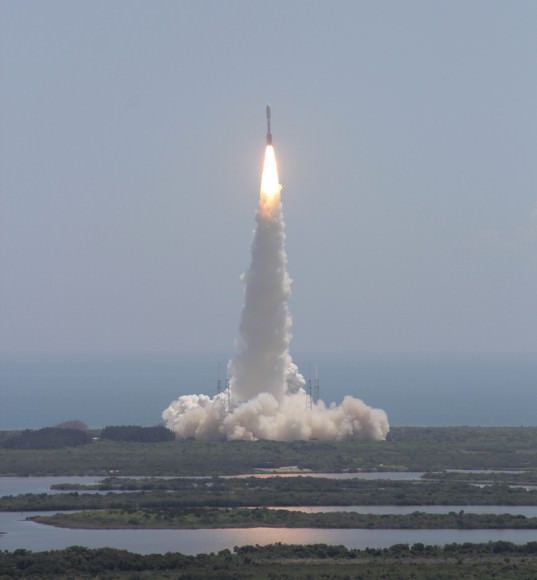
Juno’s goal is to map to the depths of the planets interior and elucidate the ingredients of Jupiter’s genesis hidden deep inside. These measurements will help answer how Jupiter’s birth and evolution applies to the formation of the other eight planets.
The 4 ton spacecraft will arrive at the gas giant in July 2016 and fire its braking rockets to go into a polar orbit and circle the planet 33 times over about one year.
The suite of nine instruments will scan the gas giant to find out more about the planets origins, interior structure and atmosphere, measure the amount of water and ammonia, observe the aurora, map the intense magnetic field and search for the existence of a solid planetary core.
“Jupiter is the Rosetta Stone of our solar system,” said Scott Bolton, Juno’s principal investigator from the Southwest Research Institute in San Antonio. “It is by far the oldest planet, contains more material than all the other planets, asteroids and comets combined and carries deep inside it the story of not only the solar system but of us. Juno is going there as our emissary — to interpret what Jupiter has to say.”
5. Opportunity reaches Endeavour Crater on Mars
The long lived Opportunity rover finally arrived at the rim of the vast 14 mile (22 kilometer) wide Endeavour Crater in mid-August 2011 following an epic three year trek across treacherous dune fields – a feat once thought unimaginable. All told, Opportunity has driven more than 34 km ( 21 mi) since landing on the Red Planet way back in 2004 for a mere 90 sol mission.
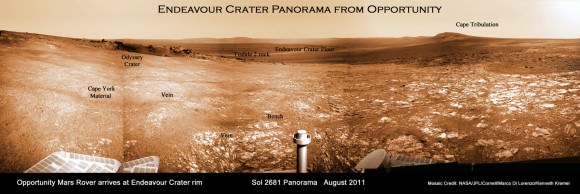
Opportunity arrived at the rim of Endeavour on Sol 2681, August 9, 2011 after a three year trek. The robot photographed segments of the huge craters eroded rim in this panoramic vista. Endeavour Crater is 14 miles (22 kilometers) in diameter. Mosaic Credit: NASA/JPL/Cornell/Marco Di Lorenzo/Kenneth Kremer
In November, the rover discovered the most scientifically compelling evidence yet for the flow of liquid water on ancient Mars in the form of a water related mineral vein at a spot dubbed “Homestake” along an eroded ridge of Endeavour’s rim.
Read my story about the Homestake discovery here, along with our panoramic mosaic showing the location – created by Ken Kremer and Marco Di Lorenzo and published by Astronomy Picture of the Day (APOD) on 12 Dec. 2011.
Watch for my upcoming story detailing Opportunity’s accomplishments in 2011.
6. GRAIL Moon Mappers
The Gravity Recovery and Interior Laboratory, or GRAIL mission is comprised of twin spacecraft tasked to map the moon’s gravity and study the structure of the lunar interior from crust to core.
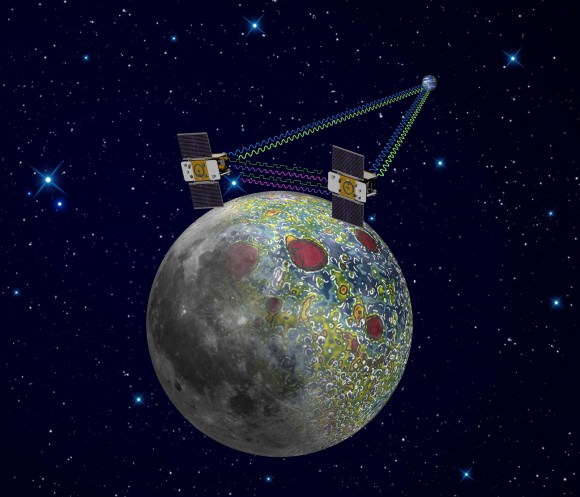
GRAIL spacecraft will map the moon's gravity field and interior composition. Credit: NASA/JPL-Caltech
The dynamic duo lifted off from Cape Canaveral on September 10, 2011 atop the last Delta II rocket that will likely soar to space from Florida. After a three month voyage of more than 2.5 million miles (4 million kilometers) since blastoff, the two mirror image GRAIL spacecraft dubbed Grail-A and GRAIL-B are sailing on a trajectory placing them on a course over the Moon’s south pole on New Year’s weekend.
Each spacecraft will fire the braking rockets for about 40 minutes for insertion into Lunar Orbit about 25 hours apart on New Year’s Eve and New Year’s Day.
Engineers will then gradually lower the satellites to a near-polar near-circular orbital altitude of about 34 miles (55 kilometers).
The spacecraft will fly in tandem and the 82 day science phase will begin in March 2012.
“GRAIL is a Journey to the Center of the Moon”, says Maria Zuber, GRAIL principal investigator from the Massachusetts Institute of Technology (MIT). “GRAIL will rewrite the book on the formation of the moon and the beginning of us.”
“By globally mapping the moon’s gravity field to high precision scientists can deduce information about the interior structure, density and composition of the lunar interior. We’ll evaluate whether there even is a solid or liquid core or a mixture and advance the understanding of the thermal evolution of the moon and the solar system,” explained co-investigator Sami Asmar to Universe Today. Asmar is from NASA’s Jet Propulsion Laboratory (JPL)
7. Curiosity Mars Rover
The Curiosity Mars Science Lab (MSL) rover soared skywards on Nov. 26, the last of 2011’s three planetary science missions. Curiosity is the newest, largest and most technologically sophisticated robotic surveyor that NASA has ever assembled.
“MSL packs the most bang for the buck yet sent to Mars.” John Grotzinger, the Mars Science Laboratory Project Scientist of the California Institute of Technology, told Universe Today.
The three meter long robot is the first astrobiology mission since the Viking landers in the 1970’s and specifically tasked to hunt for the ‘Ingredients of Life’ on Mars – the most Earth-like planet in our Solar System.
Video caption: Action packed animation depicts sequences of Curiosity departing Earth, the nail biting terror of the never before used entry, descent and landing on the Martian surface and then looking for signs of life at Gale Crater during her minimum two year expedition across hitherto unseen and unexplored Martian landscapes, mountains and craters. Credit: NASA
Curiosity will gather and analyze samples of Martian dirt in pursuit of the tell-tale signatures of life in the form of organic molecules – the carbon based building blocks of life as we know it.
NASA is targeting Curiosity to a pinpoint touch down inside the 154 km (96 mile) wide Gale Crater on Aug. 6, 2012. The crater exhibits exposures of phyllosilicates and other minerals that may have preserved evidence of ancient or extant Martian life and is dominated by a towering 3 mile (5 km) high mountain.
“10 science instruments are all aimed at a mountain whose stratigraphic layering records the major breakpoints in the history of Mars’ environments over likely hundreds of millions of years, including those that may have been habitable for life,” Grotzinger told me.
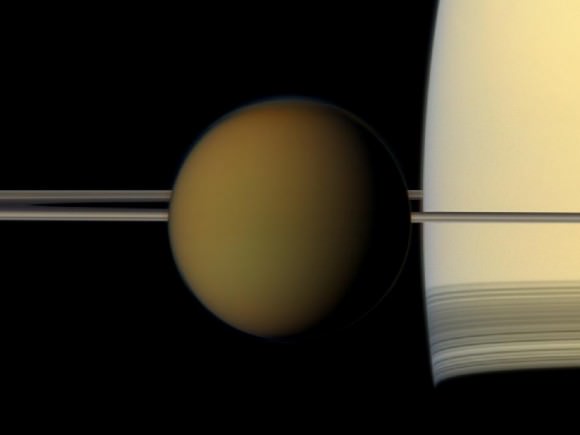
The colorful globe of Saturn's largest moon, Titan, passes in front of the planet and its rings in this true color snapshot from NASA's Cassini spacecraft. Credit: NASA/JPL-Caltech/Space Science Institute
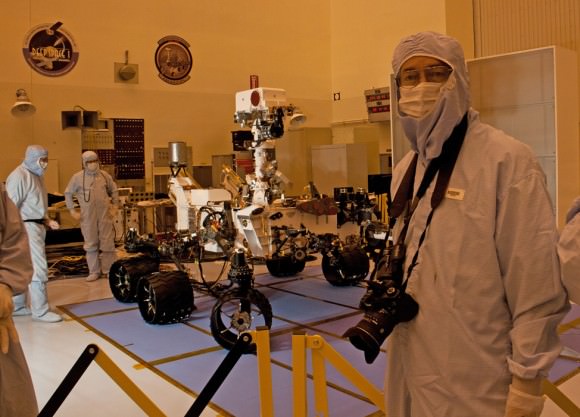
This past year Ken was incredibly fortunate to witness the ongoing efforts of many of these magnificent endeavors.


